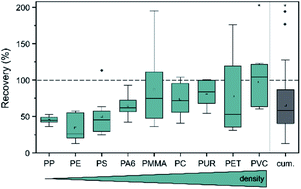Microplastic extraction from sediments established? – A critical evaluation from a trace recovery experiment with a custom-made density separator†
Abstract
By now, microplastics are present in every environmental compartment of which sediments are considered one major sink. As a result, several approaches for their enrichment from sediments have been established in microplastic analysis. At the same time, the smaller microplastics gained increasing attention regarding their ecotoxicological relevance. A customized sediment separator was evaluated with trace amounts of small microplastic particles (150–300 μm) of the nine most common polymers. Separation was performed with sodium bromide (ρ = 1.5 g cm−3). The experimental recovery comprises pristine as well as incubated polymers to include early biofouling effects. Polymer quantification was achieved exclusively using pyrolysis-gas chromatography-mass spectrometry. The results reflected an overall mean recovery of 65%. Interestingly, the observed behaviour seems to be density related. While polymers of higher densities revealed higher average extraction efficiencies (74–97%), those of less dense polymers are reduced and span between 34 and 65%. These observations hypothesize possible polarity related surface interactions as a relevant factor for microplastic particle extraction. In contrast, the density of the separation fluid seemed to be of subordinate relevance, if small microplastic particles were extracted in trace amounts. Early biofouling enhanced recoveries of some polar polymers, whereas the effect on apolar polymers was even negative in some cases. In a comparative synopsis with other published density separation approaches, a limited number of comparable experimental setups concerning particle size, polymer density range and polymer concentration were revealed. Nonetheless, some related experiments point to similar density/polarity driven extraction behaviour. In conclusion, the presented study suggests a re-evaluation of current separation approaches for extraction of low number/mass concentrations of small microplastics from sediments to enable a more comprehensive insight into factors that influence surface properties for microplastics extraction. Concurrently, it raises the question of how an ideal environment relevant recovery experiment can be designed.



 Please wait while we load your content...
Please wait while we load your content...